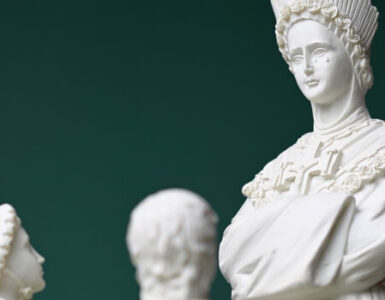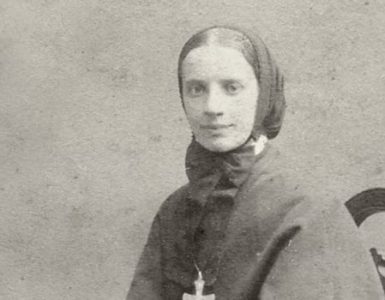“Now, Master, you may let your servant go in peace.”
Two things happened during the Presentation of Jesus in the Temple.
First, Jesus came to the temple, a little baby boy in the arms of His Mother, Mary. He came in silence and in complete obscurity and without any ostentation, “Mary and Joseph took Jesus up to Jerusalem to present Him to the Lord.” It just seemed like any other family bringing up their first-born son for the presentation rites.
Second, the aged Simeon comes into the temple led by the Spirit, “He came in the Spirit into the temple.” He did not come there by chance but he was being prompted by the Holy Spirit. The Spirit revealed to him the true identity and mission of this baby in the arms of His parents.

These two things – the God-man present in obscurity and His constant drawing us to Himself – happen in every sacramental action in the Church. In and through the seemingly ordinary rites and sacramental elements, Jesus Christ is truly present and active in every sacramental action in the Church, enlightening our minds and inflaming our wills in ways that we can never understand. Catechism #1084 puts it this way:
“Seated at the right hand of the Father and pouring out the Holy Spirit on His Body which is the Church, Christ now acts through the sacraments He instituted to communicate His grace.”
It is also Jesus Christ who draws us to Himself in the sacraments through the Holy Spirit, “No one can come to me unless the Father who sent me draws him to me.”(Jn 6:44) In short, we cannot believe in, approach, or truly appreciate the sacramental presence and action of Jesus Christ without the action of the Spirit in our lives. Human reason alone just cannot lead us to the full encounter with Christ in the sacraments of the Church.
What happens when we respond to the promptings of the Spirit and seek out Christ in the sacraments? What happens when we truly encounter Christ sacramentally with the right dispositions?
First of all, our eyes are opened and we begin to see and value things the way that Jesus sees them. Simeon’s encounter with Christ filled him with so much contentment that for him death was no longer something to be dreaded at all cost, “Now, Master, you may let your servant go in peace, according to your word, for my eyes have seen your salvation.”
Second, we experience hope that comes from true solidarity with Christ, our “merciful and faithful high priest before God.” By the grace of the sacraments, we experience deeply that Jesus “likewise shared in our blood and flesh so that He might destroy the one who has the power over death, that is, the Devil, and free those who through fear of death had been subject to slavery all their life.” We experience that Jesus is truly able to “help those who are being tested.” Sacramental grace enables us to respond in hopeful and Christ-like ways in the face of all the things that test our faith in Him.
Indeed we are being tested today in many ways. Our faith is put to the test at every moment. The Church is plagued with outrageous sexual and financial scandals. Heretical views are being propagated and accepted in a vague “spirit of dialogue.” Families are falling apart and priestly and religious vocations are dwindling. Talks of wars, natural disasters, and diseases are rampant.
More disturbing is the clamor today to begin to redefine the forms of the sacraments. There are talks of women ordination, ordination of married men, admission of divorced and remarried to the Eucharist, the abolition of celibacy, blessings of homosexual unions, etc. Those who champion and propagate such ideas fail to realize that the sacraments are first and foremost actions of the risen Christ in the Church and not a property of the Church to be modified or altered at will, not even under the guise of being “pastoral.” It is also obvious that proponents of such ideas neither value these things as Christ does nor do they believe that Jesus, who perfectly knows our weaknesses and struggles, also offers us sufficient helps to fulfill them.
It is still Christ who acts in the sacraments and who draws us to Him. It is Christ who calls a man and woman to the married state and blesses them with the necessary disposition for this. It is likewise Christ who calls a single man to give up the good and beautiful vocation of married love and embrace the discipline of celibacy for the priesthood. It is naïve and deadly to think that the Church can somehow alter this reality without grave unforeseeable consequences.
I was reminded of these two dynamic movements in each sacrament many years ago at the height of the clergy sexual abuse scandals in Boston in the winter of 2001. I met a young lady in the Church vestibule after her Holy Hour of Eucharistic adoration who told me that she was in the RCIA program that year in preparation for full membership in the Church. I asked her why she was choosing to come into the Church at a moment when the Church looked like a beehive of pedophile clergy and complicit bishops. She pointed to the tabernacle and said, “He (Jesus) wants me to fully encounter Him in His Church.” Our Eucharistic Lord, hidden under the form of ordinary bread, was beckoning on this young lady to full communion with Him in His Church which was being torn asunder by unimaginable scandals. But the pains of the scandals could not withstand her God-given desire for full communion with Him in His Catholic Church.
Our Eucharistic Lord, present and active under each humble sacramental sign, is doing the same thing today even in the midst of all the scandals and false teachings of our times. He is drawing all of humanity to Him and He is doing so through our encounter with Him in the sacraments. As we encounter Him more and more with the right disposition, He will open our eyes to see and value all things as He does and help us to respond in Christ-like ways. This is the only way we can ever hope to proclaim Christ faithfully to the world as we repeatedly echo the words of Simeon to our hidden Savior, “Now, Master, you may let your servant go in peace.”
Glory to Jesus!!! Honor to Mary!!!












